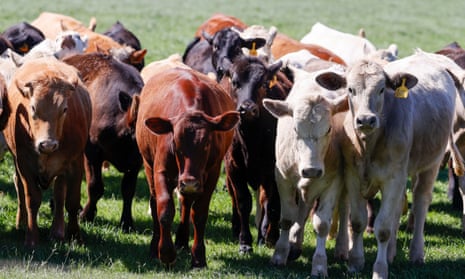Avian flu, or H5N1, is making headlines in the United States. The past few years have seen concerning signs of it spreading across the world – whether in chickens in Britain, sea lions in Peru, or Caspian seals in Russia. This time, it is has been confirmed in American cows, and the World Health Organization has warned that the risk of it spreading to humans is of “enormous concern”.
While it is early days, the hypothesis is that in late 2023, a single cow was infected by coming into contact with infected birds’ faeces, or having infected dead birds in its feed. This began cow-to-cow transmission, and potentially even cow-to-bird transmission. The US Centers for Disease Control and Prevention has also confirmed one human case of H5N1 in a farm worker, which could either represent cow-to-human (not seen before) or bird-to-human transmission.
Since being identified in late March this year (meaning it was spreading for months among cattle unnoticed), the virus has been confirmed in 33 herds in eight states. Given how infectious H5N1 is (the R number can be as high as 100 among birds – meaning each infected bird could infect 100 others – and is still unknown for cows), and the fact cows are asymptomatic or have mild symptoms, it’s likely that the spread is much farther across the country, and has perhaps reached outside the US to importers of US cattle. The US Food and Drug Administration also noted that it had found traces of the virus in roughly one in five commercially bought milk samples through PCR testing, which detects both live and dead virus fragments. Further testing is being done by the FDA to confirm that pasteurisation kills the virus; early research has found that live virus could not be grown from the milk.
The risk to the general population is still considered low, given H5N1 does not appear to transmit from human to human. Those most at risk are farm and poultry workers close to infected animals who get the virus in their eyes, nose or mouth, or inhale droplets at close range. However, the confirmed mammal-to-mammal transmission in the US is concerning to researchers given the potential for further mutations through intermediaries, such as cows, cats or pigs.
If mutations enable human-to-human spread, avian flu would become the top priority for governments around the world. The fatality rate is estimated by the World Health Organization at 52%, including young people. The US government is preparing for this scenario with a testing, treatment and vaccine plan. They confirmed this week in a press briefing that Tamiflu, a flu antiviral, is seen to be an effective treatment and is being stockpiled. Two candidate vaccines, which have been stockpiled in the US, also look well matched to this strain. We also know (all too well) that respiratory viruses spread rapidly and are very hard to contain without restrictive measures. But this is a totally different situation to SARS-CoV-2, when it took a year to develop testing, treatments and vaccines for a novel virus – we are much better prepared.
The infected cows across the pond have not triggered a UK government briefing or response yet, given that it is seen so far as a US problem, and we import our beef largely from the Republic of Ireland, New Zealand, Germany and the Netherlands.
Unlike poultry, where even one infected bird results in the culling of the entire flock, there’s no talk of killing infected cows. They can cost up to $2,500 each, are largely symptom-free, and there’s resistance from farmers to having their herds tested given the impact on their business and sales. There is no simple answer for how to contain the virus in cattle, and resolve the tension between human health imperatives and the agricultural industry. In addition, the medical world and veterinary community are notoriously bad at communicating and working together. Prof Rebecca Katz, co-author of The Outbreak Atlas, said: “This is a perfect example of the importance of operationalising One Health [a unified approach to optimising the health of humans, animals and ecosystems] and collaborations between the animal and human health sectors.”
The main message is there’s no need to panic, and this is not a repeat of the Covid-19 pandemic. H5N1 spreading mammal-to-mammal marks a step-change in the development of the disease, and there is an increased risk for humans in close contact with farms in the US. Even if it does spread into humans, the US government seems to be ahead of the curve in preparing a response plan to limit the impact on lives and livelihoods. But other governments would be wise to take heed and plan for all scenarios. To the research community trying to make sense of what’s happening, this seems to have come out of the blue – which just shows how wily and unpredictable viruses can be, and how we’re in a constant race to stay ahead of them.
Prof Devi Sridhar is chair of global public health at the University of Edinburgh

